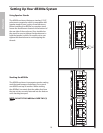
Operating the dB300a
Controls and Functions - continued
LOW FILTER
The dB300a also incorporates a Low-
cut FILTER which when engaged, will
roll off the low frequency response of
the cabinet beginning at 80Hz. The low
cut FILTER is two pole, which means
that the low frequency roll off will grad-
ually cut more and more of the low fre-
quencies (12dB per octave). When you
press the FILTER switch in, the green
LED will illuminate indicating that the
Low-cut FILTER is engaged.
OUTPUT SWITCH
The Output switch is used to select
the signal that is sent to the Line Output. You can have either a parallel output directly from the Line input, or a mixed signal
including the Mic and line inputs plus the EQ and limiter. When the switch is in the up position, the signal on the Line Output
is exactly the same as the signal on the Line Input. When the switch is in the down position, the Line Output carries the MIX of
the Mic and Line Inputs. If the Level controls, High and Low Equalizer and Filter are used, they will also affect the signal sent to
the Line Output.
Input and Output Connectors
MIC XLR Input
The dB300a’s microphone input accepts a standard low impedance (150-600 Ohms) input and the connection is made via a
standard female XLR connector. The microphone input features a high quality, discrete transistor pre-amp providing trans-
parency and extended dynamic range. The MIC input can work simultaneously with the LINE input so it is possible to use a
microphone while playing alone with a keyboard that is plugged into the dB300a’s LINE input. You can control the micro-
phone input by using the MIC LEVEL control as described in the section below.
LINE OUTPUT
You can run several monitors by using the LINE OUTPUT to daisy-chain one dB300a to another. The LINE OUTPUT is a balanced
output that, depending on the position of the OUTPUT switch,will have either a direct parallel output of the Line input, or
the Mix of the Line and Mic input. For more information on the Output switch, see section 8 above. For more information on
cables and wiring, see page 14 of this manual for a detailed wiring diagrams.
LINE Combo Balanced Input
For added convenience, the dB300a employs a Combo connector that accepts a standard XLR mic cable for balanced line level
signals, or a standard 1/4" instrument cable for either balanced (TRS – TIP/RING/SLEEVE) or unbalanced (TS – TIP/SLEEVE) line
level signals. The LINE input can work simultaneously with the Mic input so it is possible to use a microphone while playing
alone with a keyboard that is plugged into the dB300a’s LINE input. You can control the LINE input by using the LINE LEVEL
control as described in the previous page. For more information on cable and wiring, see page 14 of this manual for a detailed
wiring diagrams
7
10
9
11
7
8
8
10
9
11
ENGLISH
9


















